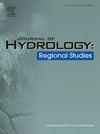Hydrologic response and prediction of future water level changes in Qinghai Lake of Tibet Plateau, China
IF 4.7
2区 地球科学
Q1 WATER RESOURCES
引用次数: 0
Abstract
Study region
The Qinghai Lake basin (QLB)
Study focus
The lake system of the Qinghai-Tibet Plateau is a crucial component of the global ecosystem. Global warming has significantly altered its water levels. To comprehensively analyze the changes in Qinghai Lake's water level and forecast its future trends, this study employs the hydrothermal coupling equilibrium theory to quantify the impact of various climate change factors. Furthermore, it incorporates CMIP6 global climate model, utilizing the Digital Watershed Model to simulate future runoff. The future water level trends of Qinghai Lake are predicted in this study using multiple regression model, allowing for the estimation of its future inundation area.
New hydrological insights for the region
The results showed that the contributions of precipitation, evaporation and underlying surface factors to the water inflow into Qinghai Lake contribute to 76.52 %, 13.97 % and 9.51 %. Notably, the QLB has experienced a progressive warming and humidification, leading to expectations of a rise in lake's water level to 3202.64 m by the year 2050. This rise will result in the expansion of the submerged area, primarily concentrated in proximity to the alluvial plains. Furthermore, it will have implications for approximately 2.8 km of the Qinghai-Tibet Railway tracks. This study reveals hydrological responses of the lake to climate change and forecasts future water level trends, offering valuable insights into regional evolution and associated environmental implications.
求助全文
约1分钟内获得全文
求助全文
来源期刊

Journal of Hydrology-Regional Studies
Earth and Planetary Sciences-Earth and Planetary Sciences (miscellaneous)
CiteScore
6.70
自引率
8.50%
发文量
284
审稿时长
60 days
期刊介绍:
Journal of Hydrology: Regional Studies publishes original research papers enhancing the science of hydrology and aiming at region-specific problems, past and future conditions, analysis, review and solutions. The journal particularly welcomes research papers that deliver new insights into region-specific hydrological processes and responses to changing conditions, as well as contributions that incorporate interdisciplinarity and translational science.
 求助内容:
求助内容: 应助结果提醒方式:
应助结果提醒方式:


